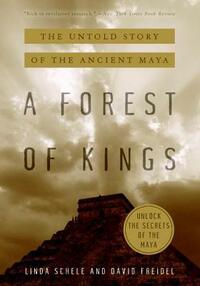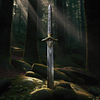Take a photo of a barcode or cover
8 reviews for:
A Forest of Kings: The Untold Story of the Ancient Maya
Linda Schele, David A. Freidel
8 reviews for:
A Forest of Kings: The Untold Story of the Ancient Maya
Linda Schele, David A. Freidel
challenging
dark
informative
mysterious
reflective
sad
slow-paced
Individual details were interesting, but overall the book has more detail than my interest level can support. Lots of death and dismemberment.
Graphic: Body horror, Child death, Death, Self harm, Torture, Violence, Blood
challenging
informative
slow-paced
An outstanding book which tells the captivating stories of several Mayan city states, illustrating different phases in the history of this very interesting and complex civilization. In my mind this book is comparable to Tuchman's classic "A Distant Mirror" in its ability to bring a period to life. There is so much still to learn about the Maya, but this book is a great introduction and at the same time makes it clear how we learn and reconstruct history from what is sometimes a scarce record. Highly recommended to readers who enjoy first rate, first hand history. This book is written by people who devoted their professional lives to uncovering the Maya.
I am officially giving up on this book at page 185. While both authors are undisputed authorities in Mayan civilization, this book has all the appeal of a research journal:
- Instead of reasonably coherent and systematic top-down treatise of the Mayan civilization, we get "lumps" of lengthy and excruciatingly boring discussions of some specific detail or event in Mayan history, what evidence there is for it, and how it is supported by the graphics discovered.
- The book is choke-full of very well done drawings of Mayan graphics that survived, but these drawings are barely annotated (the annotations that are present are of such kind an archaeologist would scribe for himself, much less for anyone else) and there is absolutely no attempt to explain it to someone who has not devoted his life to Mayan civilization research. I mean, it is great that you get an annotation like "sacrifice" pointing to an incomprehensible (to an uninitiated) jumble of lines, but that is as much explanation as you get.
Here's a good analogy from the computer world (I know, geeks here): the book is akin to being handed a grimoire on PostScript language when all you need to do is to print a couple of documents.
To summarize, if you are already well-versed in Mayan history, script, and culture, you would absolutely LOVE this book as it will greatly deepen your knowledge of specific events in Mayan history in a well supported, documented, and illustrated manner. If you are - like me - just want to learn more about Maya, their history, religion, culture, and maybe even get some very basic understanding of the principles of their writing system, this is probably not the book you are looking for.
- Instead of reasonably coherent and systematic top-down treatise of the Mayan civilization, we get "lumps" of lengthy and excruciatingly boring discussions of some specific detail or event in Mayan history, what evidence there is for it, and how it is supported by the graphics discovered.
- The book is choke-full of very well done drawings of Mayan graphics that survived, but these drawings are barely annotated (the annotations that are present are of such kind an archaeologist would scribe for himself, much less for anyone else) and there is absolutely no attempt to explain it to someone who has not devoted his life to Mayan civilization research. I mean, it is great that you get an annotation like "sacrifice" pointing to an incomprehensible (to an uninitiated) jumble of lines, but that is as much explanation as you get.
Here's a good analogy from the computer world (I know, geeks here): the book is akin to being handed a grimoire on PostScript language when all you need to do is to print a couple of documents.
To summarize, if you are already well-versed in Mayan history, script, and culture, you would absolutely LOVE this book as it will greatly deepen your knowledge of specific events in Mayan history in a well supported, documented, and illustrated manner. If you are - like me - just want to learn more about Maya, their history, religion, culture, and maybe even get some very basic understanding of the principles of their writing system, this is probably not the book you are looking for.
This incredible, eye-opening text will stay with me for a long time. To see, to hear, to feel this pre-Columbian world in their own words is a pleasure and a privalege. The written Maya language is so eloquent, clever, succinct. So compelling and beautiful.
There are tales of the great ahau (king), Kʼinich Janaab Pakal or Pakal the Great, and his son using public art to give their mothers and grandmothers royal-level legitimacy, tales of strategic arranged marriages in Yaxchilán, tales of fantastic public ritual and spiritual planes of existence, innovations in warfare in Tikal and innovative governance in Chitzén Itzá, and the age of cities winking out of existence, of the written record going dark, of final bits of public art left unfinished mid-sentence...tales of Maya survivors reaching past this dark age to the European age of exploration, the last remnants of a lost world, of books being destroyed to encourage religious conversion. And then to have modern Maya learn how to write like the ancients did, rekindling an ancient literacy...this whole book is worth the read. It is a mind-bending exploration.
I loved it. I want more.
There are tales of the great ahau (king), Kʼinich Janaab Pakal or Pakal the Great, and his son using public art to give their mothers and grandmothers royal-level legitimacy, tales of strategic arranged marriages in Yaxchilán, tales of fantastic public ritual and spiritual planes of existence, innovations in warfare in Tikal and innovative governance in Chitzén Itzá, and the age of cities winking out of existence, of the written record going dark, of final bits of public art left unfinished mid-sentence...tales of Maya survivors reaching past this dark age to the European age of exploration, the last remnants of a lost world, of books being destroyed to encourage religious conversion. And then to have modern Maya learn how to write like the ancients did, rekindling an ancient literacy...this whole book is worth the read. It is a mind-bending exploration.
I loved it. I want more.
informative
slow-paced
I picked this up even though I learned from the index that Xunantunich, one of the only Mayan sites I've visited, was mentioned only once in a throwaway line. Of course, Mayan history is interesting enough to be read about by more than academics and tourists. 'A Forest of Kings' is a deceptively fat book, its last 150 pages are appendices and endnotes, and the main text is full of illustrations which makes it a much easier read than you might think. The authors are certainly academics, but they've made a really great effort to reduce technical details to a minimum and put the bulk of their evidence into the aforementioned appendices and footnotes.
I think they did too good of a job there. Every chapter has at least one or two vignettes of hypothetical situations drawn from the archaeological and linguistic record which makes for interesting reading but they are the product of so much well-imagined guesswork that I can't suppress my skepticism even after I've flipped to the back to read the notes for that page.
The book is out of date, with almost all of the chapters referencing ongoing excavations and translation of findings, but the picture they present seemed fair-minded and, prose embellishments aside, firmly based on the evidence available to them and many of the illustrations are side-by-side simple translations of Mayan writing into English.
Reading this I understood why my professors had not assigned much reading on the history of the Maya, focusing on ecological impact instead, because there is, quite simply, a lot of one-sided historical data. With much of it, it is almost impossible to find a middle ground. There is this ~400 page treatment, and statements such as: "various small monarchic city-states exist in a state of near-constant warfare for 1000 years." A gross over-simplification, but if you want to get beyond that you're going to need to sit down and read 'A Forest of Kings', or a book of similar length.
I think they did too good of a job there. Every chapter has at least one or two vignettes of hypothetical situations drawn from the archaeological and linguistic record which makes for interesting reading but they are the product of so much well-imagined guesswork that I can't suppress my skepticism even after I've flipped to the back to read the notes for that page.
The book is out of date, with almost all of the chapters referencing ongoing excavations and translation of findings, but the picture they present seemed fair-minded and, prose embellishments aside, firmly based on the evidence available to them and many of the illustrations are side-by-side simple translations of Mayan writing into English.
Reading this I understood why my professors had not assigned much reading on the history of the Maya, focusing on ecological impact instead, because there is, quite simply, a lot of one-sided historical data. With much of it, it is almost impossible to find a middle ground. There is this ~400 page treatment, and statements such as: "various small monarchic city-states exist in a state of near-constant warfare for 1000 years." A gross over-simplification, but if you want to get beyond that you're going to need to sit down and read 'A Forest of Kings', or a book of similar length.



